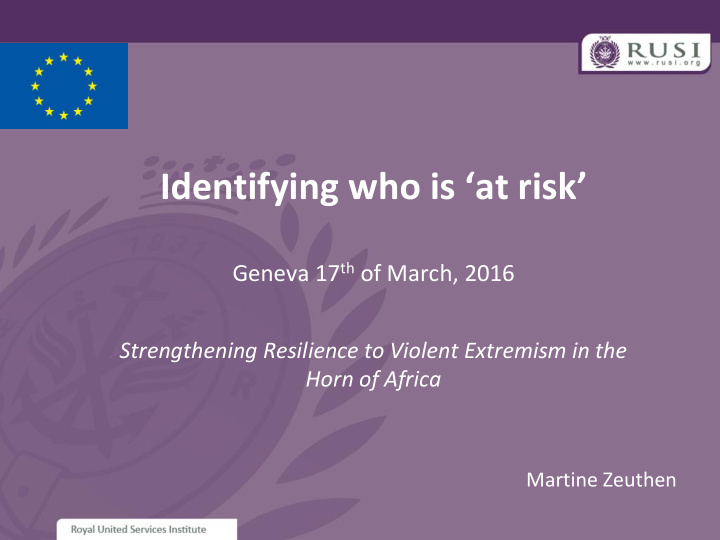



Identifying who is ‘at risk’ Geneva 17 th of March, 2016 Strengthening Resilience to Violent Extremism in the Horn of Africa Martine Zeuthen
Presentation 1. STRIVE Horn of Africa Programme 2. Approach 3. Identifying youth at risk – a theoretical discussion 4. Identifying youth at risk – practical recommendations 5. Discussion points
What is STRIVE about Purpose: • To develop best practices to implement and monitor countering violent extremism programmes in the HoA. Why • Takes the starting point that CVE is not the responsibility of any one lead Institution. Various actors have a role to play in the continuum between civil society and law enforcement. • Recognise that a multifaceted approach is needed • Focus on prevention
STRIVE: Result Areas • Result area 1: Building the regional capacity for security sector & law enforcement authorities to engage with civil society in fighting violent extremism • Result area 2: Strengthening the capacity of women organisations in Puntland & Somaliland to fight violent extremism • Result area 3 : Increasing the understanding of the challenges faced by EU born Somali Youth in Somaliland • Result area 4: Increasing the understanding of the drivers of radicalisation among youth in Kenya
Radicalisation Definition Radicalisation: A process by which individuals are introduced to an overtly ideological message and belief system that encourages movement from mainstream beliefs towards extremist views and promotion of and use of violence. The focus on process underlines the need for different actors to engage at different ‘stages’ of the process. This is however not -linear
Approach to CVE • Use local terminology (not talk about CVE directly) • Address local concerns in work (dialogue around key concerns i.e.. Issues of identity, culture, religion, generational issues, diaspora/host etc.) • Work with local actors who have knowledge and the ear of the communities (individuals or organisations) • Regional processes • Coordination with partners to optimise programming • Learn from activities to recommend ways ahead
IDENTIFYING ‘AT RISK’ INDIVIDUALS – theoretical discussion
Identifying ‘at risk’ individuals • ASSUMPTION : CVE programmes that fail to target individuals narrowly identified as ‘at risk’ of being attracted to violence will be less effective. • Of course, this is only applicable if research has adequately demonstrated that such individuals are disproportionately associated with VE, rather than basing such efforts on anecdotal evidence that may simply reflect existing prejudices and preconceptions in the societies in question.
Identifying ‘at risk’ individuals Example (s) from mentorship programme in Majengo, Nairobi. - Specific recruitment pattern is overlap between criminal violence and violent extremism Based on analysis, criteria were: - Those believed to be perpetrators / supporters of VE, or to have peers associated with VE - Those believed to be involved with crime, or to have peers associated with crime - School drop-outs - Recent converts to Islam
Identifying ‘at risk’ individuals Second phase of the project based on our initial rounds meetings and sub-sequent interviews with some of the participants helped narrowing down the ‘at risk’ group further: - Role models of the respondents - Sources of news / information - Identification with the Kenyan nationality - Perceptions of the treatment of minority groups in Kenya - Perceptions of the legitimacy of the Kenyan intervention in Somalia - Perceptions of violence in the name of religion
Identifying ‘at risk’ individuals – risks and challenges • Targeting the ‘at risk’ might provoke a response from the violent groups • The approach may contribute to the stigmatisation of the specific community. • That said, by focusing initiatives on individuals more narrowly deemed to be ‘at risk’ it is an opportunity to clarify that the targets of CVE programmes are within given communities, as opposed to being the communities themselves.
IDENTIFYING ‘AT RISK’ INDIVIDUALS – Illustration from HoA
Understanding recruitment: The case of south central, Somalia
Recruitment processes in Somalia
Review of the ToC D M EXPLORING THE AGRICULTURAL INITIATIVES ’ INFLUENCE ON STABILITY IN S OMALIA
Result area 4: Drivers of radicalisation in Kenya Starting point: understand drivers in each pilot location (ex. Majengo, Coast) Findings: Poverty and criminality in Majengo as well as historical and political grievances in the Coast. Lesson: Tailor activities very closely to context, link to work with law enforcement in RA1.
Role of civil society Each organisation has their role: • Education groups • Faith based organisations • Women’s groups • Youth groups • Media groups • Sports groups
Types of interventions • Mentorship • Inter and Intra religious dialogue (different organisations per location) • Youth debates • Media work and debate on air
Key principle: Do No Harm – easier said than done! • Research shows that it is crucial that the agenda is not perceived to be imposed by the outside and by actors who may have an external agenda • Work with local communities and engage local voices (important for by in, relations and security) • Talk about issues relevant to them • Talk about culture, language, religion, politics etc. Do not talk about ‘terrorism’
Identifying youth ‘at risk’ - a couple of questions: 1. Do we have a mutual understanding of what CVE is? 2. Are we clear on what change we are trying to make (clear theory of change) ? 3. What role can we specifically take (and who do we collaborate with)? 4. Do we understand who are ‘at risk’ for recruitment: Need for very good understanding of local politics and circumstances to identify who is at risk and how to engage (how far will / can we go?) 5. How much risk are we willing to take?
Thank You
Recommend
More recommend